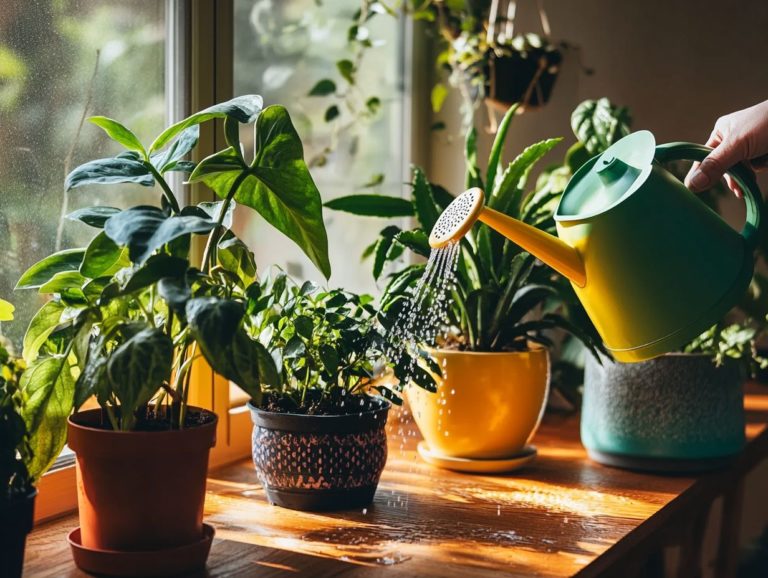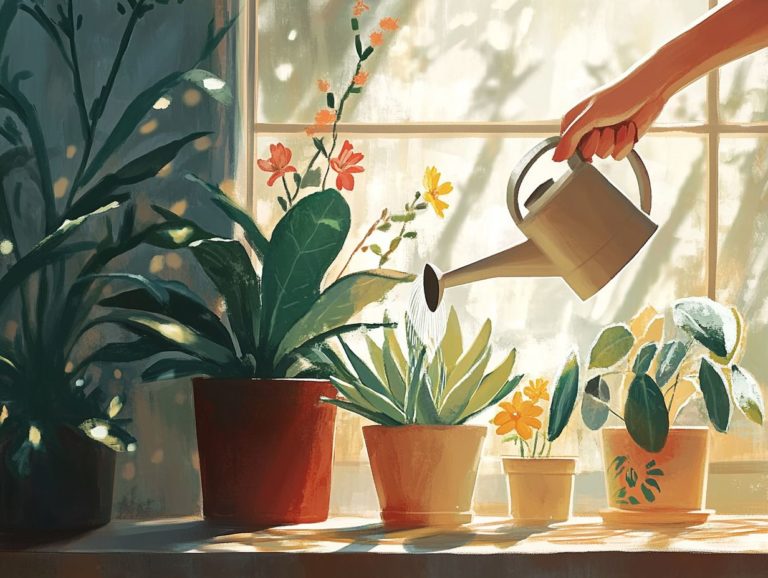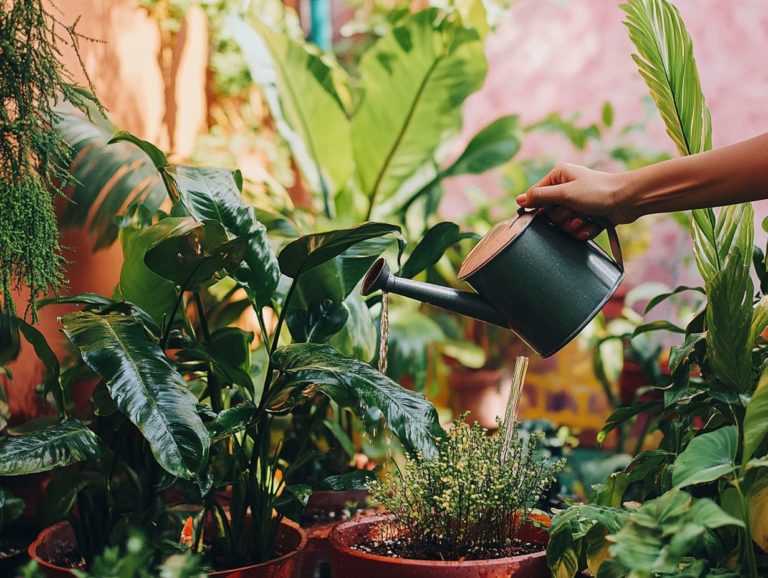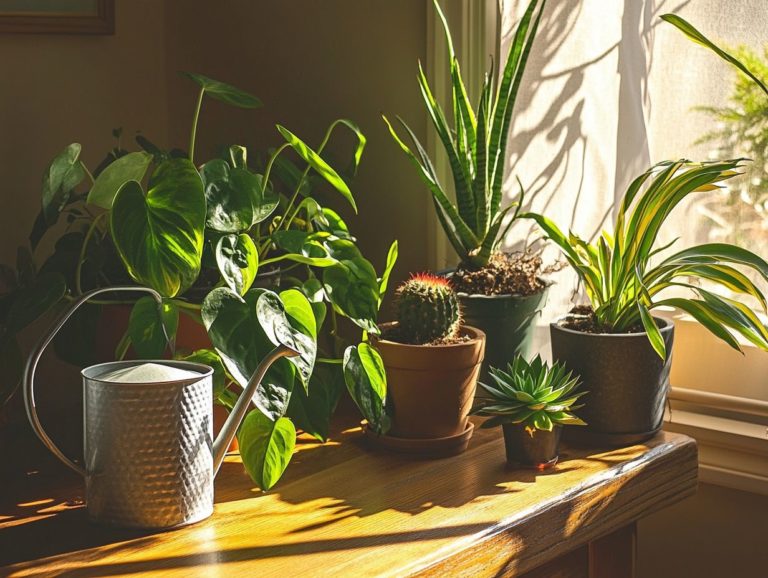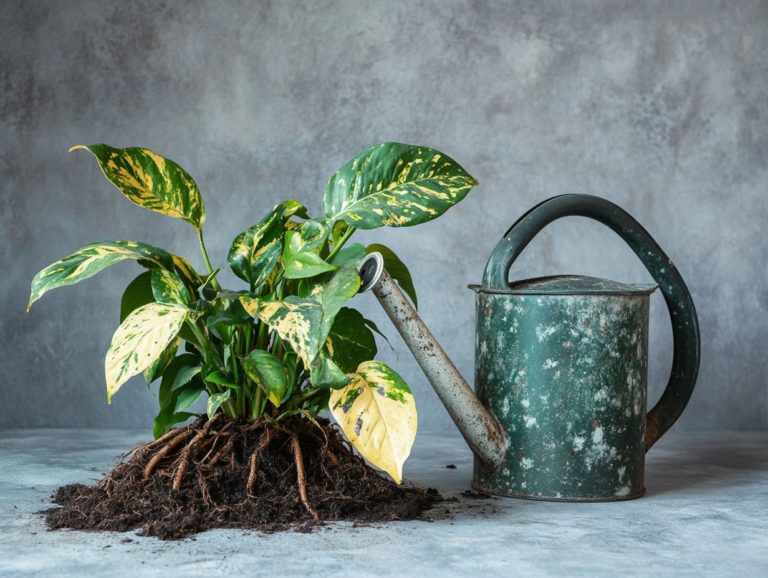5 Tips for Watering Low-Light Plants
Watering low-light plants and houseplants might seem like a delicate dance, but with the right strategy, it s simpler than it appears!
This article explores five essential tips to help you choose the best type of water for your indoor plants, understand their unique water needs, and effectively use tools like moisture meters to gauge when to water.
You ll also discover effective watering techniques and the importance of maintaining a consistent routine, ensuring your indoor plants thrive even in less-than-ideal lighting conditions.
Learn how to keep your greenery vibrant and flourishing in various indoor gardening settings!
Contents
- Key Takeaways:
- 1. Choose the Right Type of Water
- 2. Know Your Plant’s Watering Needs
- 3. Use a Moisture Meter
- 4. Water from the Bottom
- 5. Create a Consistent Watering Schedule
- How to Determine If Your Plant Needs Water?
- Frequently Asked Questions
- What are the top 5 tips for watering low-light plants?
- How often should I water my low-light plants?
- Can I use tap water for watering my low-light plants?
- What are the signs of overwatering a low-light plant?
- Can I water my low-light plants from the top or should I water from the bottom?
- Is it better to water my low-light plants in the morning or evening?
Key Takeaways:
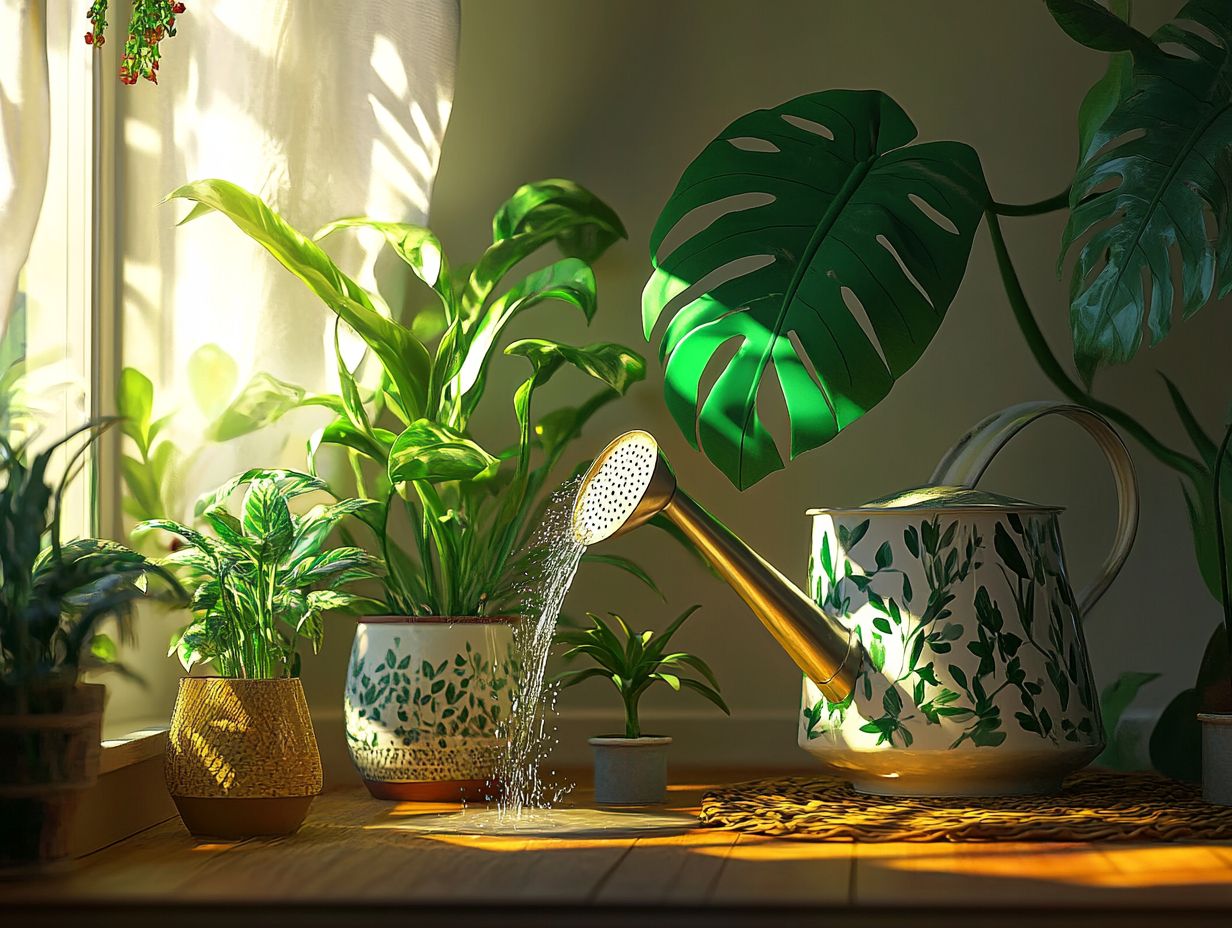
- Use filtered or distilled water to protect low-light plants from harmful chemicals.
- Understand your plant’s specific watering needs; over or under-watering can be harmful.
- A moisture meter, a device that measures soil moisture levels, can help determine when your low-light plant needs water.
1. Choose the Right Type of Water
Choosing the right type of water is vital for maintaining the health of your houseplants, as it directly influences their growth and vitality. Different water sources, such as aquarium water and distilled options, offer distinct benefits, particularly for tropical plants and succulents that thrive under specific humidity and light conditions.
For instance, rainwater is often viewed as one of the best options due to its natural composition. It s free from chemicals and residues, making it a preferred choice for many plant parents. However, it may not always be readily available. Tap water, while convenient, can contain chlorine or fluoride, which may harm sensitive houseplants. The good news is that letting it sit for 24 hours can reduce these concerns, making it safer for your indoor plants.
When making your choice, consider the humidity levels in your environment. Higher humidity may allow for a more frequent watering schedule, whereas plants in drier settings, like ferns and peace lilies, might benefit from methods that retain moisture. Light exposure also plays a crucial role in how quickly soil dries out, so use this information to support healthy growth for different plant types!
2. Know Your Plant’s Watering Needs
Understanding your plant’s watering needs is crucial for successful indoor gardening. Each plant type, such as cacti and succulents, has its own unique moisture requirements, significantly impacting its growth and health. Factors like soil type, drainage, and your personal watering routine play vital roles in preventing issues like root rot and wilting leaves.
Recognizing that succulents and cacti thrive in drier conditions due to their water-storing abilities is essential. In contrast, peace lilies and ferns prefer consistently moist soil. By checking moisture levels whether by feeling the soil with your fingers or using a moisture meter you can determine when to water and avoid over-saturation, ensuring optimal care for your plants.
As seasons change, indoor humidity levels fluctuate, impacting the watering needs of your houseplants. For example, the dry air of winter may require more frequent watering for tropical plants, which may struggle in those conditions. Adjusting to these changes not only promotes healthier plants but also creates a more vibrant indoor landscape for you to enjoy!
Start implementing these tips today and watch your plants thrive!
3. Use a Moisture Meter
Utilizing a moisture meter can truly transform your watering routine. It offers precise measurements of soil moisture levels to help you prevent overwatering and maintain optimal plant health in your indoor garden.
This invaluable tool allows you to assess the moisture content of various potting mediums. By doing so, you ensure your indoor plants receive the tailored care they deserve based on their unique water needs and soil drainage capabilities.
Regularly monitoring moisture readings helps you determine when a plant has absorbed enough water and when it s time for another drink. Act quickly to avoid root rot! For example, a reading that indicates overly saturated soil could signal an impending risk of root rot, a common issue stemming from poor drainage in container gardening.
Understanding the types of soil you use and their drainage capabilities is essential for maintaining the health of your plants. Well-draining soil types, such as those mixed with perlite a lightweight material that improves soil drainage or coarse sand, promote healthy root function by allowing excess water to escape, enhancing moisture retention only when necessary.
By integrating a moisture meter into your plant care routine, you significantly reduce the risk of related problems and nurture thriving greenery.
4. Water from the Bottom
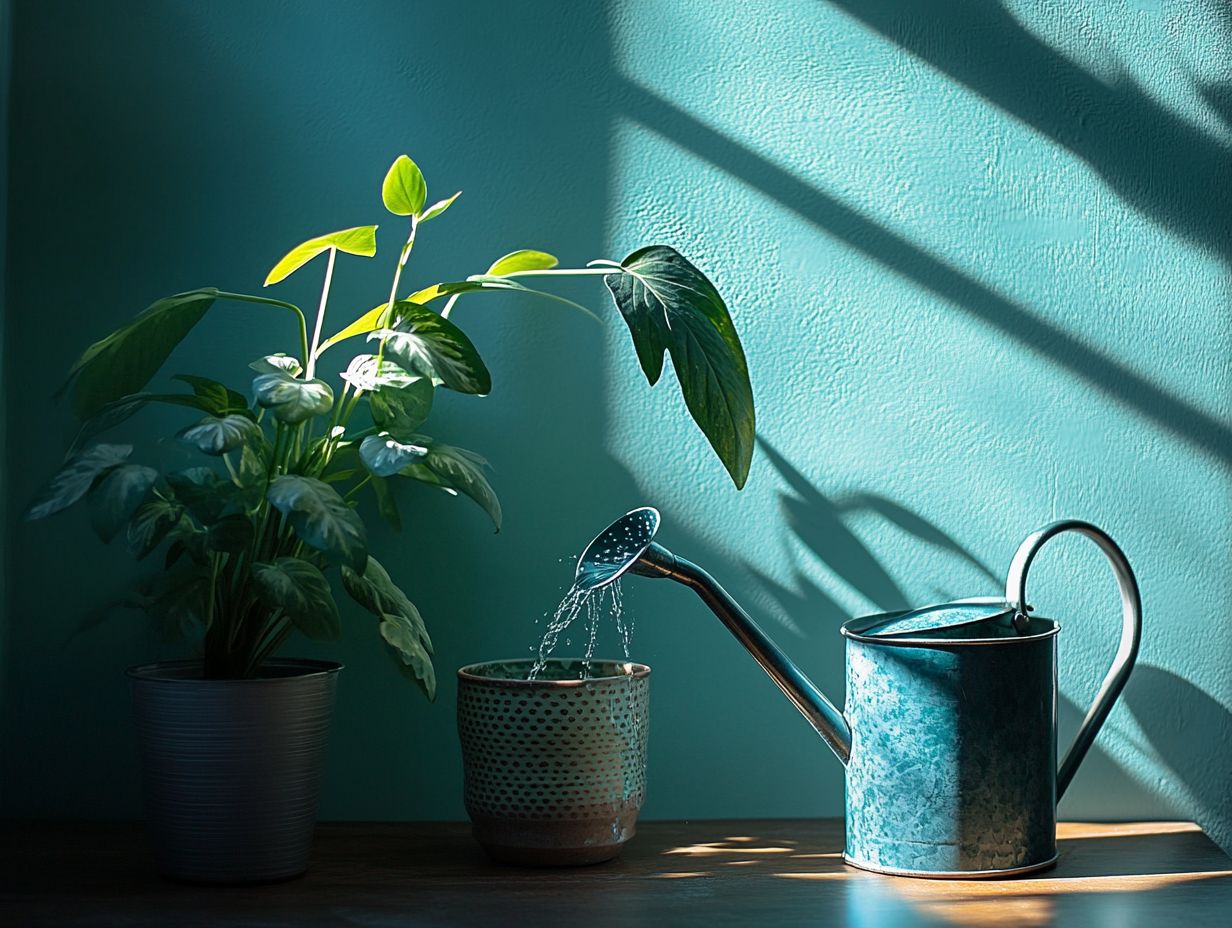
Bottom watering is an incredibly effective technique for hydrating your indoor plants, particularly for those that enjoy consistent moisture, like ferns and peace lilies. Watch as water rises through the drainage holes of pots, promoting healthy root growth and optimal moisture levels.
This method ensures the soil absorbs moisture evenly while delivering essential nutrients and enhancing air circulation around the roots of your houseplants.
For plants like ferns and peace lilies, which thrive in consistently moist soil, bottom watering can be particularly advantageous. To get started, select a basin or tray that fits your pot size, ensuring it has enough depth for adequate water absorption and proper air circulation.
Fill the basin with water and place your plant pot in it, allowing the soil to soak up moisture from the bottom for about 30 minutes to an hour. This ensures proper hydration for your indoor plants.
Opt for pots with excellent drainage ideally, those with multiple holes at the base to prevent waterlogging and promote healthy growth. Remember that smaller pots may require less soaking time, while larger containers can benefit from longer periods.
By adapting this method to the specific needs of each plant type, such as Dracaena or ZZ plants, you pave the way for optimal growth and health.
5. Create a Consistent Watering Schedule
Establishing a consistent watering schedule is essential for the healthy growth of your indoor plants and overall plant care routine. This practice helps them adapt to seasonal shifts in humidity and moisture availability.
By understanding each plant’s unique water requirements and fine-tuning your watering routine accordingly, you effectively prevent challenges like drought and overwatering.
To create a personalized watering schedule, begin by identifying the growth rates and specific needs such as light preference of each plant in your collection. For instance, fast-growing plants like tropical plants may demand more frequent watering than their slower-growing companions.
Stay attuned to seasonal variations; many plants, including certain succulents, enter a dormant phase during the colder months, requiring less water. Monitoring humidity levels is also crucial, as fluctuations in indoor humidity can significantly influence your watering frequency and overall plant health.
Utilize a moisture meter or check the top inch of soil to determine the optimal time to hydrate your plants. Ensure that each one receives precisely what it needs to thrive, especially in varying light conditions.
Start using these tips today for healthier plants!
How to Determine If Your Plant Needs Water?
Determining whether your indoor plants need water is an essential skill for anyone who cares for plants, especially in maintaining their overall health. Signs like wilting leaves or dry soil are clues to varying levels of moisture deficiency, guiding your watering routine.
By observing your plants closely and understanding their specific water needs taking into account factors like humidity and light conditions you can provide the proper care they require for vibrant, healthy growth. This ensures they thrive throughout the seasons.
The texture of the soil is crucial for this assessment. Sandy soils drain quickly and may need more frequent watering, while clay soils retain moisture for longer, affecting overall plant health. If your plants are in bright light, they will likely release more water, increasing their hydration demands. Conversely, those in low-light environments might not need as much water, so adjusting your watering routine is essential.
Don t overlook humidity levels either. Dry air can intensify water loss, leading to crispy or brown edges on foliage, impacting your indoor gardening efforts. By being attuned to these indicators, you give yourself the power to keep your green companions thriving.
What Are the Best Types of Water for Low-Light Plants?
Regarding low-light plants such as Dracaena and ZZ plants, the type of water you use can significantly impact their health and growth. These plants often require specific nutrients and moisture levels to thrive, so choosing the right water can enhance their resilience and vitality.
For example, using distilled or rainwater can be particularly beneficial for these species, helping them achieve optimal moisture balance. Both options are free from chlorine, salts, and other contaminants often found in tap water, which can hinder nutrient absorption and overall health. Distilled water is produced through a process that removes impurities, providing a clean slate for your low-light plants to draw essential minerals from the soil.
Rainwater, on the other hand, is naturally soft and rich in nitrogen, making it an excellent choice for nurturing those delicate leaves of your houseplants. By selecting these preferred water types, you can easily create a thriving home for your plants!
What Are the Signs of Overwatering and Underwatering?
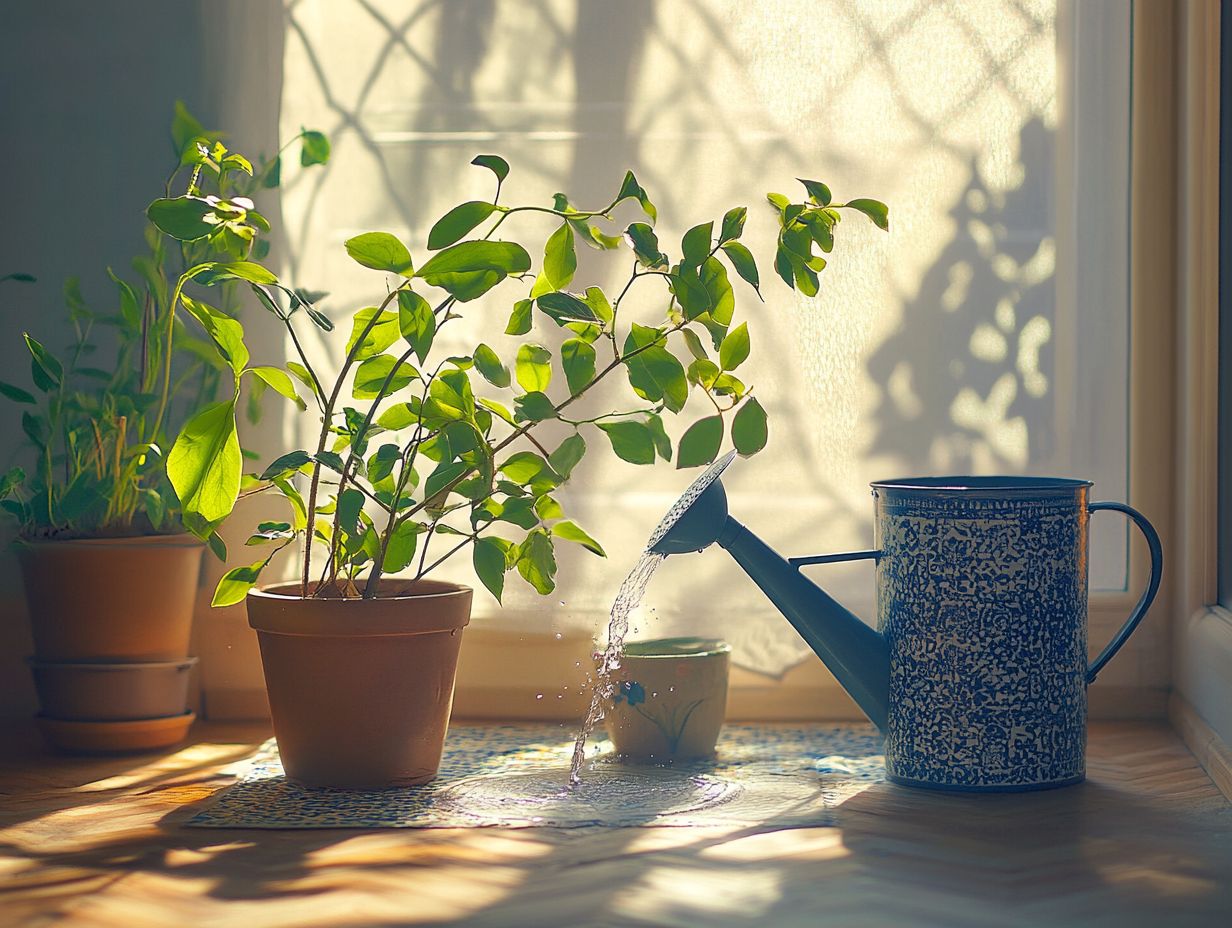
Recognizing the signs of overwatering and underwatering is essential for maintaining your indoor plants’ health and growth. Both conditions can lead to severe issues like root rot a condition where roots decay due to excess moisture and wilting leaves, impacting overall vitality.
Overwatering often manifests through yellowing leaves, where the foliage appears droopy or even mushy. In contrast, underwatering reveals itself with crispy, brown leaf tips and dry soil that pulls away from the pot edges. Observing these physical indicators reminds you to adjust your watering routine.
To remedy these issues, check the soil moisture regularly. You can use your finger to gauge its dryness or employ a moisture meter for a precise reading. If overwatering is at play, allow the soil to dry out and improve drainage. For underwatering, a thorough soak followed by a consistent watering schedule can help restore vitality to your beloved plants.
Act now to prevent your plants from suffering! Are you ready to become an expert in plant care and ensure your indoor garden flourishes?
What Are the Benefits of Using a Moisture Meter?
Using a moisture meter brings a wealth of benefits for plant enthusiasts like you. A moisture meter helps you take accurate readings that can refine your watering routines and elevate your plants’ overall health.
This essential tool allows you to customize your watering strategy according to soil type and moisture levels. It creates a thriving environment for your indoor greenery.
Avoiding overwatering or underwatering is simple with a moisture meter. It significantly improves your plants’ growing conditions by eliminating the guesswork around watering. Each species receives the hydration it craves, reducing the risk of root rot or drought stress.
Whether you’re caring for succulents that flourish in dry soil or tropical plants that crave more moisture, employing a moisture meter can lead to more vibrant foliage and robust roots. It makes caring for your plants easier and gives you the power to be a more attentive caretaker of your leafy companions.
How Can Bottom Watering Benefit Low-Light Plants?
Bottom watering can greatly enhance the well-being of your low-light plants by providing them with the moisture they need while significantly reducing the risk of overwatering and root rot.
This method allows your plants to absorb water at their own pace, improving plants taking in nutrients and helping them grow better in those dim conditions.
By submerging the bases of your pots in water, your plants can draw what they require without the anxiety of overly saturated soil. This technique is especially beneficial for resilient varieties like snake plants, pothos, and ZZ plants, which thrive in low-light environments. For more tips, check out the best watering techniques for indoor plants.
Bottom watering helps retain moisture, keeping the soil consistently damp without turning it into a soggy mess. For the best results, check in on your plants regularly and allow them to drink for about 30 minutes before lifting them out of the water.
This straightforward yet effective approach not only encourages strong root systems but also cultivates more resilient plants that can weather periods of low light with ease.
What Are the Best Times to Water Low-Light Plants?
Determining the best times to water your low-light plants is vital for their health. The timing can greatly impact their moisture levels and overall vitality.
By syncing your watering routine with seasonal changes and humidity levels, you can ensure your plants receive the optimal hydration they need to thrive in your indoor spaces.
It’s essential to recognize that humidity and temperature can vary significantly throughout the seasons. For instance, in warmer months, increased humidity can lead to quicker evaporation of water, meaning you ll need to check moisture levels more frequently.
On the flip side, during the cooler months, the lower temperatures and reduced light may require less frequent watering. Keep an eye on your plants’ activity be it new growth or signs of wilting as they can offer valuable clues about their moisture needs.
Adjusting your watering schedule to accommodate these fluctuations will help create a balanced environment for your low-light plants to flourish.
Frequently Asked Questions
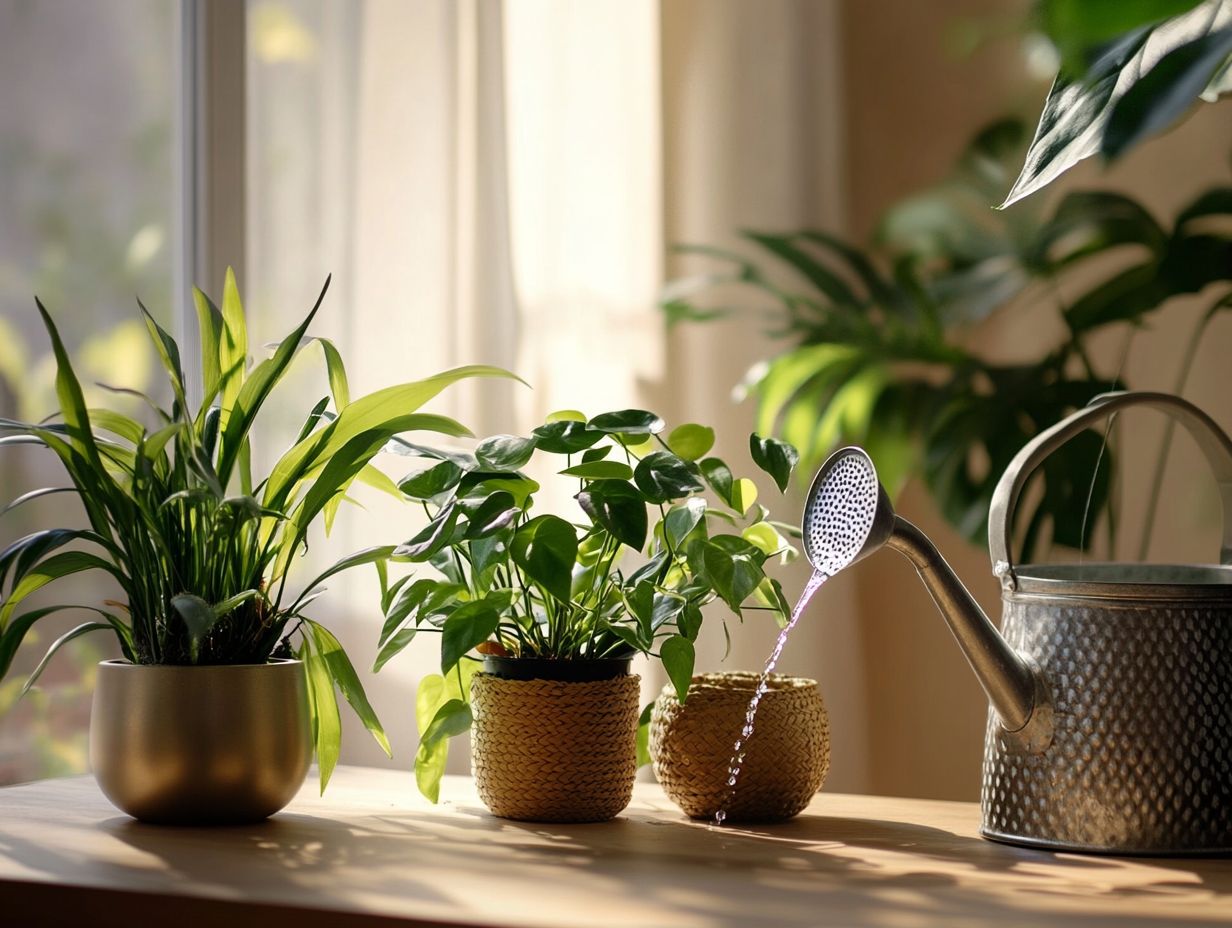
What are the top 5 tips for watering low-light plants?
- Observe the moisture level of the soil before watering to prevent overwatering.
- Water less frequently but with a thorough soak to mimic natural rainfall.
- Use room temperature water to prevent shocking the plants.
- Avoid misting, as it can promote fungal growth and spread diseases.
- Consider using a self-watering system, which allows plants to draw water as needed, or place the plant in a tray with pebbles and water to create humidity.
How often should I water my low-light plants?
Check the soil every week! If the top inch is dry, it s time for watering. It’s generally better to underwater than to overwater, so always check the soil before watering.
Can I use tap water for watering my low-light plants?
Tap water is usually fine for watering low-light plants. However, it’s important to let it sit for at least 24 hours to allow any chlorine or fluoride to evaporate. You can also use filtered water, aqua water, or collect rainwater for your plants, especially when considering their humidity needs.
What are the signs of overwatering a low-light plant?
Look for yellowing or wilting leaves, mold or fungus on the soil, and foul odors. If you see these signs, water less and ensure your plant has good drainage.
Can I water my low-light plants from the top or should I water from the bottom?
Water your low-light plants from the bottom.
Place them in a tray of water for a few minutes. This helps the roots soak up water and keeps the leaves dry, reducing the risk of harmful fungus.
Is it better to water my low-light plants in the morning or evening?
Water in the morning! This gives your plants time to dry before the cooler evening temperatures.
They ll absorb the water and nutrients they need throughout the day.

